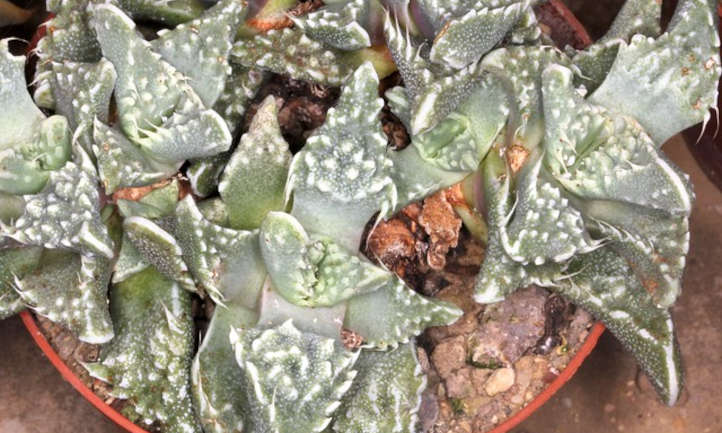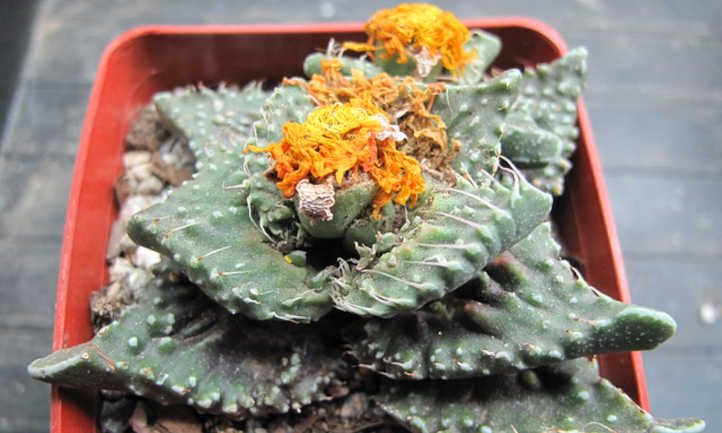Whether called “tiger jaws,” Faucaria tuberculosa stands out with its rosettes resembling wide-open jaws, creating the illusion of a gathering of voracious green creatures. The leaf surfaces are adorned with dense white tubercles or wart-like bumps, while their edges are lined with soft white structures reminiscent of teeth, adding to the plant’s distinctiveness.
Despite its somewhat sinister aesthetic, tiger jaws are considered attractive due to their pleasing colors and compact shape. Additionally, they produce beautiful daisy-like flowers that open during the day and close in the late afternoon. While native to Cape Province, South Africa, this perennial succulent can adapt easily to indoor environments among houseplants or outdoor ground coverings.
Faucaria tuberculosa thrives in zones 9-11, tolerating light frost in winter but flourishing in full sun. If exposed to excessive heat, growth may slow down. To assist you in cultivating this unique plant successfully, we will share essential tips for caring for this monstrous succulent!
Quick Care Guide


| Common Name | Shark’s jaws, knobby tiger jaws, pebbled tiger jaws, tiger jaws, warty tiger jaws |
| Scientific Name | Faucaria felina subsp. Tuberculosa, Faucaria tuberculosa |
| Family | Aizoaceae |
| Height & Spread | 6 inches tall, 10-12 inches spread |
| Light | Full sun |
| Soil | Well-draining |
| Water | Soak and dry |
| Pests & Diseases | Mealybugs, rot |
All About Faucaria Tuberculosa


Faucaria tuberculosa, although commonly referred to as such, has undergone a name change to Faucaria felina subsp. tuberculosa since 1999. This change reflects its ability to interbreed with other subspecies under the Faucaria felina species from Cape Province. While often mislabeled in nurseries as Faucaria tigrina, the distinct features of this plant make it relatively easy to identify correctly.
The Faucaria genus encompasses numerous species and hybrids, displaying variability in their jaw-like tubercles, a trait shared by many native to Cape Province. While nicknames like “tiger jaws” are common among these plants, careful observation of specific characteristics helps differentiate the genuine Faucaria felina subsp. Tuberculosa from others.
Characterized by pairs of thick, triangular leaves with white tubercles and teeth-like structures, these low-growing rosettes produce a central daisy-like flower with yellow petals that open and close daily. With proper care, mature plants bloom in fall, with flowers lasting into early spring, eventually giving way to bell-shaped fruits containing seeds. These seeds are dispersed gradually, ensuring continuous growth opportunities in suitable environments.
Care


While Faucaria tuberculosa boasts unique characteristics with its white tubercles, its care regimen closely mirrors that of other Faucarias. Here, we provide comprehensive guidance for nurturing these captivating tiger jaws plants and their relatives.
Sun and Temperature
Faucaria
Sunlight Tolerance
Tuberculosa thrives in the arid, warm landscapes of Cape Province in South Africa. For optimal growth, position it in full sun outdoors or near a south-facing window indoors. While it enjoys sunlight, high temperatures can harm your pebbled tiger jaws, so consider providing some light shade during summer.
Shade Precautions
If you decide to offer shade to your succulent, do so sparingly. Pebbled tiger jaws are highly susceptible to etiolation, visible through leggy growth if light is insufficient. If you notice elongation, promptly transition the plant to a brighter location.
Cold Tolerance
Faucaria felina subsp. tuberculosa is a resilient succulent capable of withstanding light frost down to 23°F. In colder conditions, ensure your tiger jaws remains dry. If you reside in a region colder than hardiness zone 9, it’s advisable to keep your Faucaria tuberculosa indoors.
Water and Humidity
Similar to other succulents, Faucaria tuberculosa stores water to survive prolonged dry periods. Avoid excessive moisture by allowing the soil to completely dry out before watering. Use a moisture meter or manually check the topsoil to gauge watering needs.






